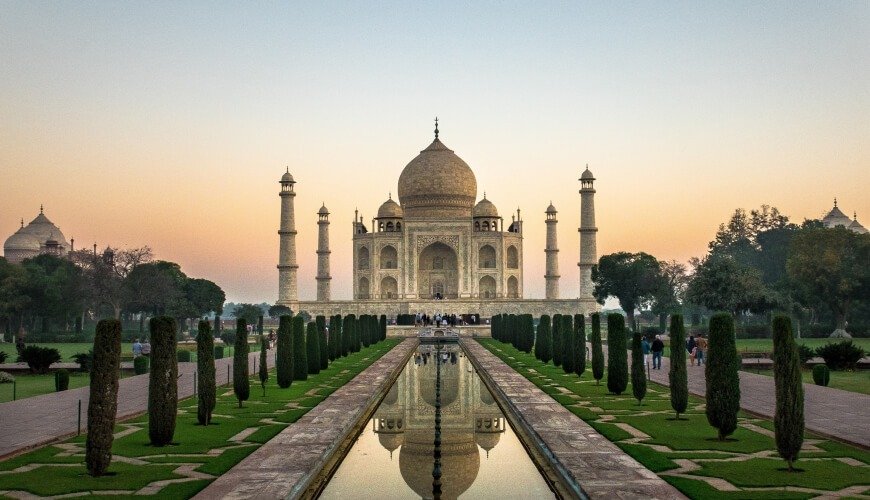
You’ve never been to India before, but you’re dying to see the Taj Mahal, Goa or colourful Rajasthan? If so, here’s some help to get you started.
Many travellers feel overwhelmed when planning their trip to India. But it’s not that difficult if you take it one step at a time. Here are 11 tips to help you plan your trip.
1 Get your India visa in time!
A visa is required to enter India. Under certain conditions, visitors can obtain an e-Tourist Visa (e-TV). This visa normally allows you to stay in the country for up to 60 days and to enter the country up to two times. Up-to-date information and regulations can be found on the website indianvisaonline. You can also apply for the visa at the embassy.
2 Take your time planning your trip!
India is a huge country, the seventh largest in the world. So you need to think carefully about where you want to go. Take your time to plan your trip, read a travel guide or travel blog and make a list of places you are interested in. This is useful because you probably won’t remember many of the complicated names the first time. Just write everything down, you can always cross it off later. For example, create a map on Google Maps and put a flag for each possible destination. This will give you a feel for distances and connections. Never forget: Planning trips is fun!
3 Not too much at once!
As just described, India is big, not to say very big. So at some point you will have to decide where you want to go. Accepting the following might help:
“It doesn’t matter how much time you have, it won’t be enough for everything!”
So don’t stress the first time and just come back. And remember that everything in India takes a long time. Whether you are waiting at the ticket counter or at the post office, patience is always required. Also, a stomach bug or a cold caused by the air conditioning can throw you off track at any time. It’s a good idea to build in time buffers. In my opinion, you should allow at least three weeks for a self-organised trip to India, and visit a maximum of seven places, or better still five if you want to relax.
4 If you have less time …
Can’t wait and want to see as much of India as possible in a short time? Then a study tour (e.g. Studienreisen.de) might be the right thing for you. It costs a bit more, but you’ll have a well-organised, compact programme where you don’t have to worry about anything.
5 Choose the right time to visit India!
The best time to travel to India is from October to March, with the high season running from around December to the end of February. This is when the temperatures are most comfortable. In the low season, from April to June, it is very hot and visiting a temple can be an ordeal. Many national parks are closed. From June, the monsoon brings a lot of rain to the country. You can still experience this in the low season from July to October.
Also important for your travel planning: India has many major festivals that are well worth visiting. Check the dates against your itinerary and maybe you’ll be lucky enough to attend one. But even if you’re not planning to attend a festival, it’s a good idea to check the Indian calendar, as many trains and accommodation are booked up on the days around the festival.
6 Make sure you are up to date with your vaccinations!
The World Health Organization recommends vaccinations against tetanus, diphtheria, polio, hepatitis A & B, typhoid and chickenpox (if applicable) for India. Depending on your itinerary and length of stay, vaccinations against Japanese encephalitis, meningitis, rabies and tuberculosis are also recommended. It is best to consult a tropical institute or a doctor specialising in travel medicine. Although much can be done at short notice, it is best to see a doctor three to four months before travelling. Not all vaccines are always in stock and some vaccinations require several appointments.
By the way: Most health insurance companies will pay for vaccinations recommended by your doctor.
7 Don’t let them scare you!
A few years ago, the first pages of some guidebooks were devoted to the dangers of diseases and poisonous animals. Fortunately, these lists of horrors have been moved to the back of most guidebooks, as it is more pleasant to get to know the good things about a destination first. I’m not trying to play down the dangers, because some of them are real. But they don’t have to make you crazy. With a little caution and common sense, you can avoid most of the dangers and minimise the risks.
8 Make a packing list for your trip to India!
Good travel planning is also necessary when it comes to what you want to take with you to India. In the end, it is usually too much and something is always missing. You should therefore start writing down the items on your packing list well in advance.
9 Plan your finances and budget properly!
Before you travel, you should have a clear idea of your budget. Build in a buffer so that unexpected expenses don’t ruin your trip. You should also think about how you will get money in India.
10 Restaurants: Eat where the Indians eat!
Indian cuisine is one of the best in the world. Unfortunately, many people on holiday in India only eat in upmarket restaurants for fear of spoiling their stomachs. But this means you miss out on a lot, because the food is often adapted for a Western audience. The unique taste experiences are usually to be found in more basic restaurants. They are also much cheaper. Sometimes you can get your fill for as little as one euro.
And the worries: I go to eat with my group whenever possible at street stalls and small restaurants in India and almost never had any problems. I always made sure that (lots of) locals were eating there. That is a sign that the food is good. Of course, you can ruin your stomach there, but that can happen in any restaurant. Be especially careful with restaurants that are not very popular and have a western menu.
11 Take a deep breath!
India is demanding, a land of contrasts and definitely not an easy destination. You may fall in love with India and have a wonderful time, or you may be disappointed and never come back. Be prepared for long journeys, sensory overload and a lack of understanding. Take your time and accept that. Taking a breath instead of getting upset will make a lot of things easier. And it will help you to enjoy the fascinating aspects of this country. Have a good trip!


